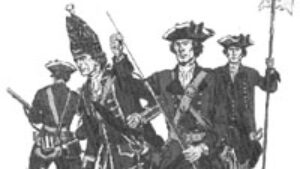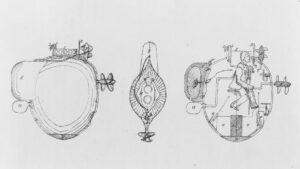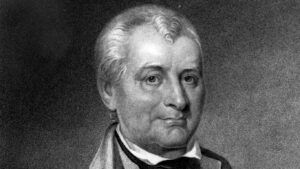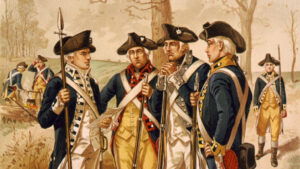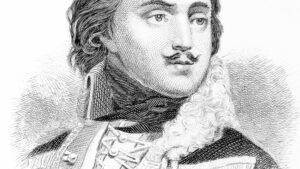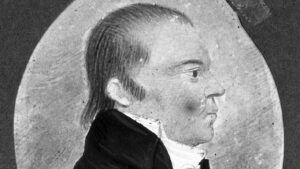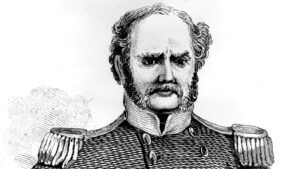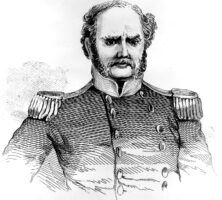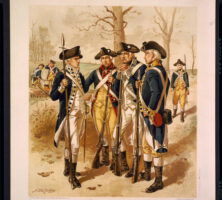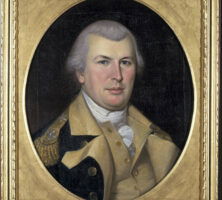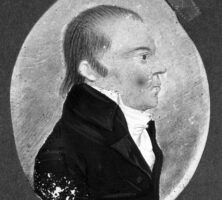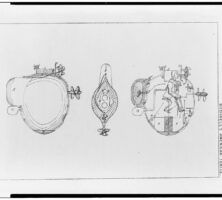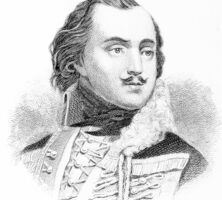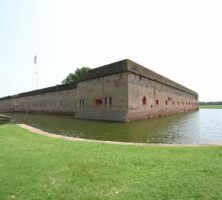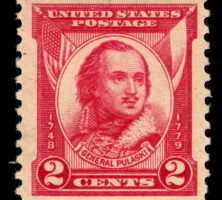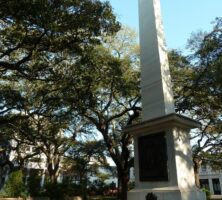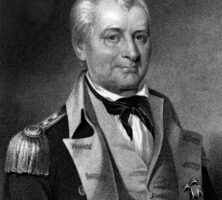The New Georgia Encyclopedia is supported by funding from A More Perfect Union, a special initiative of the National Endowment for the Humanities.
David Emanuel Twiggs, a U.S. Army general, surrendered U.S. forces to Confederate authorities in Texas when that state seceded from the Union in 1861. He was the son of prominent Revolutionary War general John Twiggs and nephew of Georgia governor David Emanuel.
The New Georgia Encyclopedia does not hold the copyright for this media resource and can neither grant nor deny permission to republish or reproduce the image online or in print. Requests for permission to publish or reproduce the resource should be submitted to the Hargrett Manuscript and Rare Book Library at the University of Georgia.
Henry Alexander's lithograph Infantry: Continental Army, 1779-1783 depicts the uniforms and weapons used by the Continental Army during the Revolutionary War.
Courtesy of Library of Congress, Prints and Photographs Division
The New Georgia Encyclopedia does not hold the copyright for this media resource and can neither grant nor deny permission to republish or reproduce the image online or in print. All requests for permission to publish or reproduce the resource must be submitted to the rights holder.
Nathanael Greene was one of the most respected generals of the Revolutionary War and a talented military strategist. As commander of the Southern Department of the Continental army, his leadership was the catalyst that turned the tide toward American victory in Georgia.
Courtesy of Independence National Historical Park
The New Georgia Encyclopedia does not hold the copyright for this media resource and can neither grant nor deny permission to republish or reproduce the image online or in print. All requests for permission to publish or reproduce the resource must be submitted to the rights holder.
Sheftall Sheftall was the eldest son of Mordecai Sheftall, a successful Savannah merchant, shipper, and statesman. In 1777, during the Revolutionary War, Mordecai became a colonel, and he named Sheftall as his assistant. The following year both men were taken as prisoners by the British and held in the Caribbean for two years before being released.
Courtesy of Hargrett Rare Book and Manuscript Library, University of Georgia Libraries, Georgia Photo File.
The New Georgia Encyclopedia does not hold the copyright for this media resource and can neither grant nor deny permission to republish or reproduce the image online or in print. Requests for permission to publish or reproduce the resource should be submitted to the Hargrett Manuscript and Rare Book Library at the University of Georgia.
Connecticut native and, later, Georgia resident David Bushnell invented the submarine. He created the first prototype of a manned submarine, called the "Turtle," in the 1770s. His design was used in the Revolutionary War against the British.
Courtesy of Library of Congress, Prints and Photographs Division
The New Georgia Encyclopedia does not hold the copyright for this media resource and can neither grant nor deny permission to republish or reproduce the image online or in print. All requests for permission to publish or reproduce the resource must be submitted to the rights holder.
Count Casimir Pulaski was one of Georgia's most notable military heroes during the Revolutionary War. A Polish nobleman, Pulaski was killed while leading an unsuccessful charge against the British during the 1779 Siege of Savannah.
Courtesy of Georgia Historical Society, Foltz Photography Studio (Savannah, Ga.), photographs, 1899-1960, #GHS 1360-25-13-14.
The New Georgia Encyclopedia does not hold the copyright for this media resource and can neither grant nor deny permission to republish or reproduce the image online or in print. All requests for permission to publish or reproduce the resource must be submitted to Georgia Historical Society.
Fort Pulaski, situated on Cockspur Island at the mouth of the Savannah River, was built in the 1830s and 1840s to defend Savannah. During the Civil War, Union forces captured the fort on April 11, 1862, and controlled it for the remainder of the war.
Photograph by Brooke Novak
The New Georgia Encyclopedia does not hold the copyright for this media resource and can neither grant nor deny permission to republish or reproduce the image online or in print. All requests for permission to publish or reproduce the resource must be submitted to the rights holder.
This drawing by a British officer details the failed attempt by American and French forces to recapture Savannah from British troops on October 9, 1779.
Courtesy of Hargrett Rare Book and Manuscript Library, University of Georgia Libraries, Rare Maps Collection.
The New Georgia Encyclopedia does not hold the copyright for this media resource and can neither grant nor deny permission to republish or reproduce the image online or in print. Requests for permission to publish or reproduce the resource should be submitted to the Hargrett Manuscript and Rare Book Library at the University of Georgia.
General Casimir Pulaski, featured on this 1931 U.S. postage stamp, joined American forces in the Revolutionary War. Fort Pulaski, near the mouth of the Savannah River, bears his name.
Courtesy of the Smithsonian National Postal Museum
The New Georgia Encyclopedia does not hold the copyright for this media resource and can neither grant nor deny permission to republish or reproduce the image online or in print. All requests for permission to publish or reproduce the resource must be submitted to the rights holder.
The New Georgia Encyclopedia does not hold the copyright for this media resource and can neither grant nor deny permission to republish or reproduce the image online or in print. All requests for permission to publish or reproduce the resource must be submitted to the rights holder.
A monument to Revolutionary War general Nathanael Greene stands in Johnson Square, in Savannah.
Image from sfgamchick
The New Georgia Encyclopedia does not hold the copyright for this media resource and can neither grant nor deny permission to republish or reproduce the image online or in print. All requests for permission to publish or reproduce the resource must be submitted to the rights holder.
Soldiers from Fort Screven stand in formation during the 1902 reinterment of Revolutionary War general Nathanael Greene in Savannah's Johnson Square.
Courtesy of Georgia Archives, Vanishing Georgia, #
ctm257.
The New Georgia Encyclopedia does not hold the copyright for this media resource and can neither grant nor deny permission to republish or reproduce the image online or in print. Requests for permission to publish or reproduce the resource should be submitted to the Georgia Archives.
Three companies of the British Sixtieth Regiment of Foot were sent to the Georgia colony in 1763 by King George III to strengthen the defense of colonial garrisons against attack by the French and Spanish.
Courtesy of The Company of Military Historians
The New Georgia Encyclopedia does not hold the copyright for this media resource and can neither grant nor deny permission to republish or reproduce the image online or in print. All requests for permission to publish or reproduce the resource must be submitted to the rights holder.
Lachlan McIntosh distinguished himself in a career that evolved over three critical eras in the state's early history, from the colonial period to the Revolutionary War to statehood.
The New Georgia Encyclopedia does not hold the copyright for this media resource and can neither grant nor deny permission to republish or reproduce the image online or in print. All requests for permission to publish or reproduce the resource must be submitted to the rights holder.
